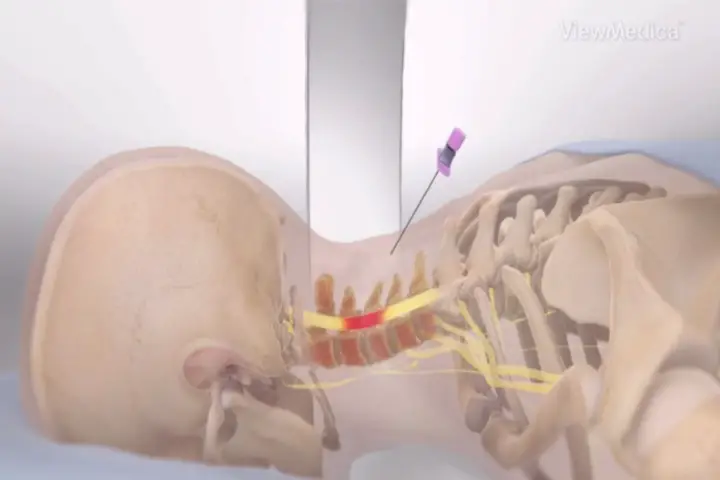Although it relieves back pain, cervical infiltration may sometimes be inadvisable (and even prohibited) in certain situations. This is what we will talk about in this article: when to avoid cervical infiltration ?
Definition
What does “cervical infiltration” mean?
Cervical infiltration is defined by injection local of a drug: a anti-inflammatory made of cortisone (such as hydrocortancyl).
It is called "local" since it is carried out directly at the level of the area from which the pain cervical.
The aim of this therapeutic procedure is to use a minimum of powerful active substance which will act directly on the target area instead of spreading throughout the body (case of oral medications). It is then carried out very precisely at the level of the fatty zone of space epidural of the vertebral canal.
How does it work and what are these indications?
As mode of action, seepage reduces the inflammations at the level of region cervical. These are the main sources of pain.
This is why treatment by cervical infiltration can effectively provide relief in cases of neck pain persistent, radiculalgia upper limb or also herniated disc cervical. These are, moreover, its main indications.
This therapeutic technique is rather appropriate if these disorders have persisted for more than 7 months and that treatments with analgesics or physiotherapy have not worked.
How is cervical infiltration performed?
First, a consultation specialist (with a radiologist) is essential.
After confirmation, the patient is placed in a prone position on the scanner table to better identify the area to be infiltrated. The latter is then disinfected and anesthetized. Then, we perform the injection of a contrast product followed by seepage de corticosteroid proper. After removing the needle, the Pad.
The patient should stay in s for the next thirty minutes seepage, before he can finally go home.
For more details on everything related to this infiltration cervical, click here.
Contraindications of cervical infiltration
Infiltration is absolutely prohibited under certain conditions :
- Un dysfunction cardiovascular such as hemodynamic instability, heart rhythm disorders, abnormal blood pressure, acute heart failure.
- A thrombopathy : platelet dysfunction syndrome, severe thrombocytopenia, etc. These platelet disorders disrupt hemostasis and thus blood clotting. In these cases, then it is necessary avoid seepage at the risk of aggravating bleeding and making it more difficult to control bleeding.
- Un bleeding disorder probably linked to hemophilia (predisposition to bleeding), Von Willebrand's disease, taking anticoagulant treatment (for example: aspirin, kardegic, plavix, previscan, etc.). When the blood is too fluid, the risk of bruising increases. They also complicate the control of bleeding.
In reality, these contraindications are also explained by the effects secondary and the modes of action of products of infiltration (iodine solution and cortisone). Cortisone is particularly involved in the regulation of water balance, that of sodium and other electrolytes. Where do the seepage effects on blood pressure which can be very problematic for patients who suffer from the diseases concerned.
Infiltration is also proscribed for all patients, who previously suffered from a cervical trauma. The same is true for patients who suffer from significant neurological deficit.
It is also not suitable forinfection (which often manifests as a feverish state), sepsis or infection in the area where the needle is to be inserted.
There are also salary.-indications on which may possibly allow seepage cervical if this is accompanied by monitoring and special attention. These cases relate to:
- the allergic to one of the components of the infiltration substances;
- the diabetics since cortisone is involved in maintaining blood sugar levels.
This treatment is also contraindicated for the reasons of risks complications that it contains.
Risks of cervical infiltration
Like any invasive treatment, even with the respect of the necessary precautions, seepage cervical is not without risks and is sometimes accompanied by complications.
- Personalized infections on the injection zone: they are relatively lesser (almost 1%). However, they can spread and worsen into sepsis, epidural abscesses, inflammation of the meninges, bones, joints, discs and vertebral bodies surrounding areas.
- Personalized bleeding : in case of accidental damage to the vessels, or the diseases mentioned above.
- Personalized allergies and shock anaphylactic related to intolerance of the products used.
- Personalized complications neurological : stroke, epidural hematomas, lesions of the spinal cord, seizures, loss of vision, pneumencephaly, spinal cord infarction or central, quadriplegia.
At worst, these complications can be life-threatening for the patient.
What to do ? What are the alternative treatments?
If possible, preference should always be given to conventional first-line treatments: medications analgesics, physiotherapy, etc.
If these do not work, and cervical infiltration is prohibited, it would be necessary to consider other conservative and alternative treatments.
It is possible to try to relieve inflammation and pain cervical with the use of natural remedies for example. In this case, the use of hot, cold and essential oils (like that of wintergreen, peppermint, lavender) can be of great help.
It is also possible to prevent the pain and improve the patient's living conditions through gentle muscle strengthening exercises (like swimming).
So, in case of contraindication of cervical infiltration, it is better to favor these solutions mentioned above. If there are no responses to these treatments, consideration should be given to surgery.
In any case, seeking and following the advice of health professionals is always essential.
Projects
https://www.hss.edu/conditions_steroid-side-effects-how-to-reduce-corticosteroid-side-effects.asp





